Spatial Influence of Digital Economy on Carbon Emission Efficiency of the Logistics Industry across 30 Provinces in China
Abstract
:1. Introduction
- CEE of LI and DE are two intricate industrial systems that encompass various dimensions, multiple source elements, and multiple indicators. Therefore, accurately measuring and evaluating the CEE of LI and DE systems is a crucial prerequisite for conducting research on the effect of the DE on LI’s CEE.
- Several factors must be considered when studying the effect of the DE on LI’s CEE. Therefore, it is necessary to scientifically perform data processing and model construction to provide a quantitative basis for proposing targeted policy recommendations on LI’s CEE and the development of the DE.
- Considering regional resource endowments, LI, and the level of DE development, it is necessary to formulate tailored policies for the digital and low-carbon transformation development of LI, as well as DE development strategies.
2. Materials and Methods
2.1. Research Framework
2.2. Index System
2.3. Data Source and Processing
2.3.1. Calculation of Carbon Emissions
2.3.2. Calculating the Weights of DE System Indicators
2.4. Data Model
2.4.1. Model of Development Level
2.4.2. SBM Model for Unexpected Output
2.4.3. Moran’s Index Model
2.4.4. OLS Model
2.4.5. GWR Model
2.5. Data Application
3. Case Study
3.1. Background of the Case Study
3.2. Results
3.2.1. Analysis of the Development Level of DE
3.2.2. Analysis of the Logistic Industry’s CEE
3.2.3. Spatial Autocorrelation Analysis of the Logistic Industry’s CEE
3.2.4. Analysis of Regression Results
4. Discussion
5. Conclusions, Policy Implications, and Directions for Future Research
5.1. Policy Implications
5.2. Future Research Directions
Author Contributions
Funding
Institutional Review Board Statement
Informed Consent Statement
Data Availability Statement
Acknowledgments
Conflicts of Interest
References
- Chen, J.; Lian, X.; Su, H.; Zhang, Z.; Ma, X.; Chang, B. Analysis of China’s carbon emission driving factors based on the perspectives of eight major economic regions. Environ. Sci. Pollut. Res. 2021, 28, 8181–8204. [Google Scholar] [CrossRef] [PubMed]
- Cheng, Z.; Li, L.; Liu, J.; Zhang, H. Total-factor carbon emission efficiency of China’s provincial industrial sector and its dynamic evolution. Renew. Sustain. Energy Rev. 2018, 94, 330–339. [Google Scholar] [CrossRef]
- Shi, X.; Zheng, Y.; Lei, Y.; Xue, W.; Yan, G.; Liu, X.; Cai, B.; Tong, D.; Wang, J. Air quality benefits of achieving carbon neutrality in China. Sci. Total. Environ. 2021, 795, 148784. [Google Scholar] [CrossRef] [PubMed]
- Zhang, R.; Hanaoka, T. Deployment of electric vehicles in China to meet the carbon neutral target by 2060: Provincial disparities in energy systems, CO2 emissions, and cost effectiveness. Resour. Conserv. Recycl. 2021, 170, 105622. [Google Scholar] [CrossRef]
- Gao, P.; Yue, S.; Chen, H. Carbon emission efficiency of China’s industry sectors: From the perspective of embodied carbon emissions. J. Clean. Prod. 2021, 283, 124655. [Google Scholar] [CrossRef]
- Yang, J.; Tang, L.; Mi, Z.; Liu, S.; Li, L.; Zheng, J. Carbon emissions performance in logistics at the city level. J. Clean. Prod. 2019, 231, 1258–1266. [Google Scholar] [CrossRef]
- Guo, X.; Wang, D. Analysis of the spatial relevance and influencing factors of carbon emissions in the logistics industry from China. Environ. Sci. Pollut. Res. Int. 2022, 29, 2672–2684. [Google Scholar] [CrossRef]
- Wang, J.; Lim, M.K.; Tseng, M.-L.; Yang, Y. Promoting low carbon agenda in the urban logistics network distribution system. J. Clean. Prod. 2019, 211, 146–160. [Google Scholar] [CrossRef]
- Li, Z.; Wang, J. The Dynamic Impact of Digital Economy on Carbon Emission Reduction: Evidence City-level Empirical Data in China. J. Clean. Prod. 2022, 351, 131570. [Google Scholar] [CrossRef]
- Wang, X.; Zhong, M. Can digital economy reduce carbon emission intensity? Empirical evidence from China’s smart city pilot policies. Environ. Sci. Pollut. Res. Int. 2023, 30, 51749–51769. [Google Scholar] [CrossRef]
- Li, Y.; Yang, X.; Ran, Q.; Wu, H.; Irfan, M.; Ahmad, M. Energy structure, digital economy, and carbon emissions: Evidence from China. Environ. Sci. Pollut. Res. Int. 2021, 28, 64606–64629. [Google Scholar] [CrossRef] [PubMed]
- Chen, J.; Gui, W.; Huang, Y. The impact of the establishment of carbon emission trade exchange on carbon emission efficiency. Environ. Sci. Pollut. Res. Int. 2022, 30, 19845–19859. [Google Scholar] [CrossRef] [PubMed]
- Cheng, S.; Qu, G. Research on the Effect of Digital Economy on Carbon Emissions under the Background of “Double Carbon”. Int. J. Environ. Res. Public 2023, 20, 4931. [Google Scholar] [CrossRef] [PubMed]
- Han, D.; Ding, Y.; Shi, Z.; He, Y. The impact of digital economy on total factor carbon productivity: The threshold effect of technology accumulation. Environ. Sci. Pollut. Res. Int. 2022, 29, 55691–55706. [Google Scholar] [CrossRef]
- Zhang, L.; Mu, R.; Zhan, Y.; Yu, J.; Liu, L.; Yu, Y.; Zhang, J. Digital economy, energy efficiency, and carbon emissions: Evidence from provincial panel data in China. Sci. Total. Environ. 2022, 852, 158403. [Google Scholar] [CrossRef]
- Xu, Q.; Zhong, M.; Cao, M. Does digital investment affect carbon efficiency? Spatial effect and mechanism discussion. Sci. Total. Environ. 2022, 827, 154321. [Google Scholar] [CrossRef]
- Quan, C.; Cheng, X.; Yu, S.; Ye, X. Analysis on the influencing factors of carbon emission in China’s logistics industry based on LMDI method. Sci. Total. Environ. 2020, 734, 138473. [Google Scholar] [CrossRef]
- Deng, F.; Xu, L.; Fang, Y.; Gong, Q.; Li, Z. PCA-DEA-tobit regression assessment with carbon emission constraints of China’s logistics industry. J. Clean. Prod. 2020, 271, 122548. [Google Scholar] [CrossRef]
- Xu, B.; Xu, R. Assessing the role of environmental regulations in improving energy efficiency and reducing CO2 emissions: Evidence from the logistics industry. EIA Rev. 2022, 9, 106831. [Google Scholar] [CrossRef]
- Li, M.J.; Wang, J. Spatial-temporal evolution and influencing factors of total factor productivity in China’s logistics industry under low-carbon constraints. Environ. Sci. Pollut. Res. Int. 2021, 29, 883–900. [Google Scholar] [CrossRef]
- Tang, Y.; Yang, Z.; Yao, J.; Li, X.; Chen, X. Carbon emission efficiency and spatially linked network structure of China’s logistics industry. Front. Environ. Sci. 2022, 30, 166–200. [Google Scholar] [CrossRef]
- Zhong, W.; Yang, J.; Zheng, M.; Dong, J.; Yan, Z. The impact and transmission mechanism of China’s urban digital economy on carbon emissions in the logistics industry. China Environ. Sci. 2024, 44, 427–437. [Google Scholar] [CrossRef]
- Wang, H.; Li, Y.; Lin, W.; Wei, W. How does digital technology promote carbon emission reduction? Empirical evidence based on e-commerce pilot city policy in China. J. Environ. Manag. 2023, 325, 116524. [Google Scholar] [CrossRef] [PubMed]
- Liu, W.; Wang, Y. Effect and mechanism of digital economy empowering urban green and high-quality development. South China J. Econ. 2022, 8, 73–91. [Google Scholar] [CrossRef]
- Wang, Q.; Ge, Y.; Li, R. Evolution and driving factors of ocean carbon emission efficiency: A novel perspective on regional differences. Mar. Pollut. Bull. 2023, 194 Pt A, 115219. [Google Scholar] [CrossRef]
- Xie, N.-Y.; Zhang, Y. The Impact of Digital Economy on Industrial Carbon Emission Efficiency: Evidence from Chinese Provincial Data. Math. Probl. Eng. 2022, 2022, 6583809. [Google Scholar] [CrossRef]
- Zhang, W.; Liu, X.; Wang, D.; Zhou, J. Digital economy and carbon emission performance: Evidence at China’s city level. Energy Policy 2022, 165, 112927. [Google Scholar] [CrossRef]
- Ran, Q.; Yang, X.; Yan, H.; Xu, Y.; Cao, J. Natural resource consumption and industrial green transformation: Does the digital economy matter? Resour. Policy 2023, 5, 103396. [Google Scholar] [CrossRef]
- Liao, X.; Yang, Z. Effect Measurement and realization path of transformation and upgrading of digital economy enabling manufacturing industry in the Yangtze River Delta. East China Econ. Manag. 2021, 35, 22–30. [Google Scholar] [CrossRef]
- Wang, Z.; Xu, X.; Zhu, Y.; Gan, T. Evaluation of carbon emission efficiency in China’s airlines. J. Clean. Prod. 2019, 243, 118500. [Google Scholar] [CrossRef]
- Cai, B.; Guo, H.; Ma, Z.; Wang, Z.; Dhakal, S.; Cao, L. Benchmarking carbon emissions efficiency in Chinese cities: A comparative study based on high-resolution gridded data. Appl. Energy 2019, 242, 994–1009. [Google Scholar] [CrossRef]
- Wei, L.; Hou, Y. Research on the Impact of China’s Digital Economy on Urban Green Development. J. Quant. Tech. Econ. 2022, 39, 60–79. [Google Scholar] [CrossRef]
- Guo, Y.; Mao, H.; Ding, H.; Wu, X.; Liu, Y.; Liu, H.; Zhou, S. Data-Driven Coordinated Development of the Digital Economy and Logistics Industry. Sustainability 2022, 14, 8963. [Google Scholar] [CrossRef]
- Yu, H.; Wang, J.; Xu, J. Assessing the role of digital economy agglomeration in energy conservation and emission reduction: Evidence from China. Energy 2023, 284, 128667. [Google Scholar] [CrossRef]
- Zheng, Y.H.; Guo, L. Impact of the digital economy on the carbon efficiency of the tourism industry and its threshold effect. China Popul. Resour. Environ. 2023, 33, 69–79. [Google Scholar] [CrossRef]
- Salahuddin, M.; Alam, K. Internet usage, electricity consumption and economic growth in Australia: A time series evidence. Telematics Informatics 2015, 32, 862–878. [Google Scholar] [CrossRef]
- Kristoffersen, E.; Blomsma, F.; Mikalef, P.; Li, J. The smart circular economy: A digital-enabled circular strategies framework for manufacturing companies. J. Bus. Res. 2020, 120, 241–261. [Google Scholar] [CrossRef]
- Popkova, E.G.; Sergi, B.S. A Digital Economy to Develop Policy Related to Transport and Logistics. Predictive Lessons from Russia. Land Use Policy 2020, 99, 105083. [Google Scholar] [CrossRef]
- Wang, L.; Chen, L.; Li, Y. Digital economy and urban low-carbon sustainable development: The role of innovation factor mobility in China. Environ. Sci. Pollut. Res. 2022, 29, 48539–48557. [Google Scholar] [CrossRef]
- Ma, D.; Zhu, Q. Innovation in emerging economies: Research on the digital economy driving high-quality green development. J. Bus. Res. 2022, 145, 801–813. [Google Scholar] [CrossRef]
- Wang, J.; Dong, K.; Dong, X.; Taghizadeh-Hesary, F. Assessing the digital economy and its carbon-mitigation effects: The case of China. Energy Econ. 2022, 113, 106198. [Google Scholar] [CrossRef]
- Jiang, Y.; Lan, T.; Wu, L. A Comparison Study of Missing Value Processing Methods in Time Series Data Mining. In Proceedings of the International Conference on Computational Intelligence & Software Engineering, Wuhan, China, 11–13 December 2009; Volume 12. [Google Scholar] [CrossRef]
- IPCC. Global Warming of 1.5 °C. An IPCC Special Report on the Impacts of Global Warming of 1.5 °C Above Pre-Industrial Levels and Related Global Greenhouse Gas Emission Pathways, in the Context of Strengthening the Global Response to the Threat of Climate Change, Sustainable Development, and Efforts to Eradicate Poverty. 2018. Available online: https://www.ipcc.ch/sr15/ (accessed on 4 August 2023).
- Zhang, C.; Zhang, Z. Agglomeration effect and radiation effect of Carbon emission intensity at Provincial level in China. J. Environ. Sci. 2017, 37, 1178–1184. [Google Scholar]
- Tone, K. A slacks-based measure of efficiency in data envelopment analysis. Eur. J. Oper. Res. 2001, 130, 498–509. [Google Scholar] [CrossRef]
- Zhang, Y.; Liu, Y.; Zhang, Y.; Liu, Y.; Zhang, G.; Chen, Y. On the spatial relationship between ecosystem services and urbanization: A case study in Wuhan, China. Sci. Total Environ. 2018, 10, 780–790. [Google Scholar] [CrossRef]
- Kleiber, C. Finite sample efficiency of OLS in linear regression models with long-memory disturbances. Econ. Lett. 2001, 72, 131–136. [Google Scholar] [CrossRef]
- Chao, L.; Zhang, K.; Li, Z.; Zhu, Y.; Wang, J.; Yu, Z. Geographically weighted regression based methods for merging satellite and gauge precipitation. J. Hydrol. 2018, 558, 275–289. [Google Scholar] [CrossRef]
- Dong, F.; Hu, M.; Gao, Y.; Liu, Y.; Zhu, J.; Pan, Y. How does digital economy affect carbon emissions? Evidence from global 60 countries. Sci. Total. Environ. 2022, 852, 158401. [Google Scholar] [CrossRef]
- Ding, H.; Liu, Y.; Zhang, Y.; Wang, S.; Guo, Y.; Zhou, S.; Liu, C. Data-driven evaluation and optimization of the sustainable development of the logistics industry: Case study of the Yangtze River Delta in China. Environ. Sci. Pollut. Res. 2022, 29, 68815–68829. [Google Scholar] [CrossRef]
- Xie, X.; Wang, J. Study on the impact of industrial digitization on carbon emissions: Evidence from China’s Logistics Industry. Environ. Res. Commun. 2023, 5, 105008. [Google Scholar] [CrossRef]
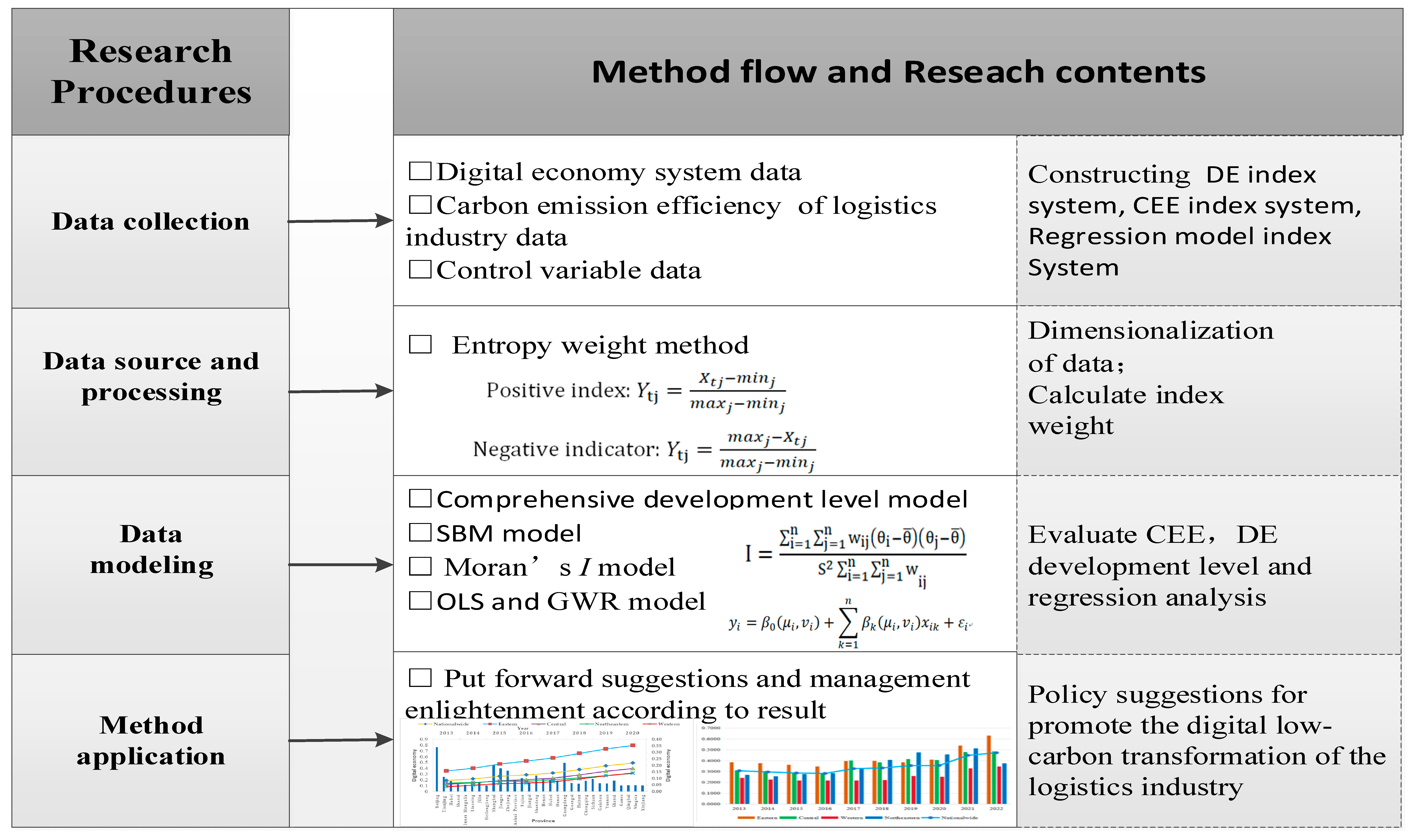
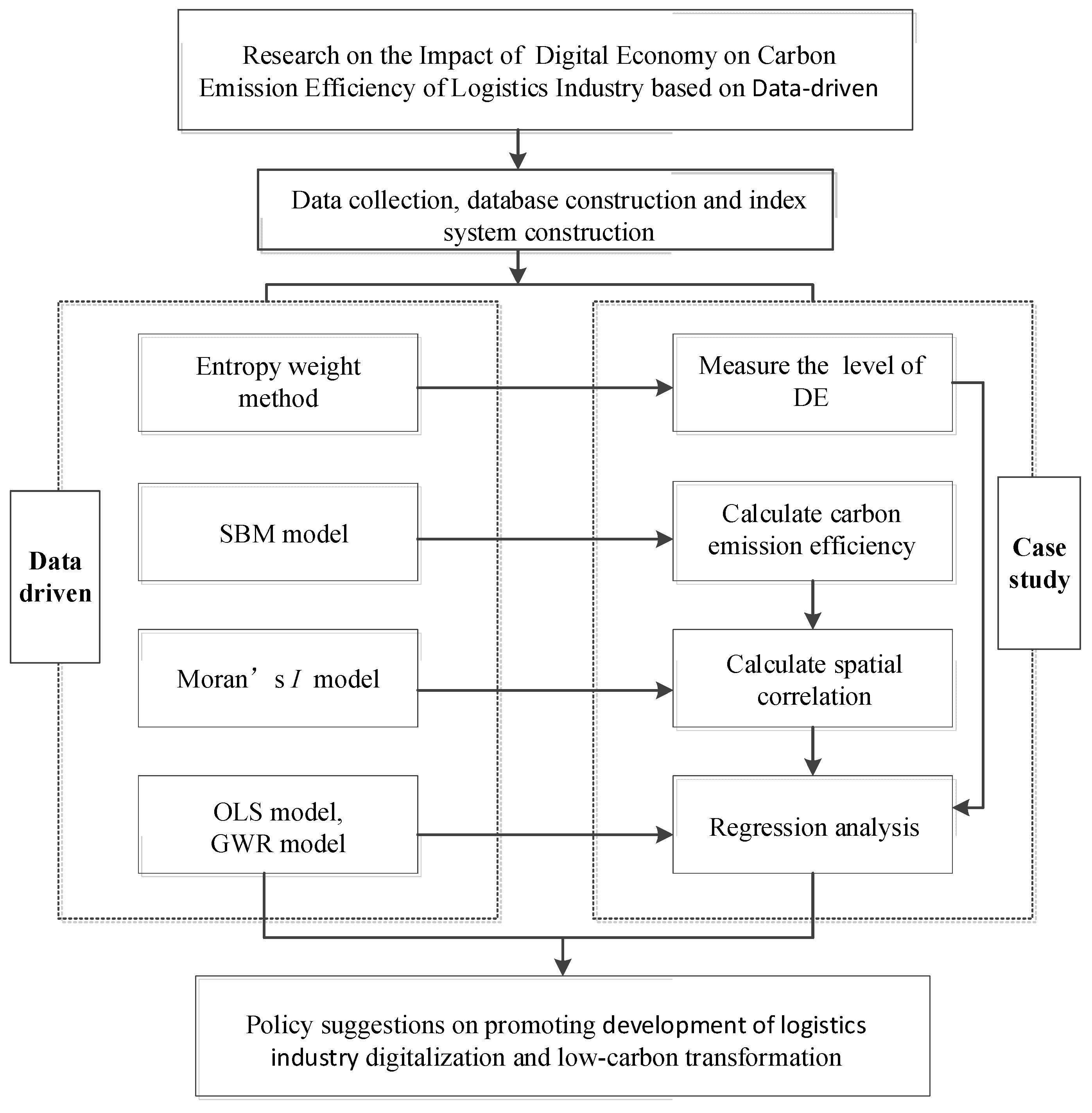
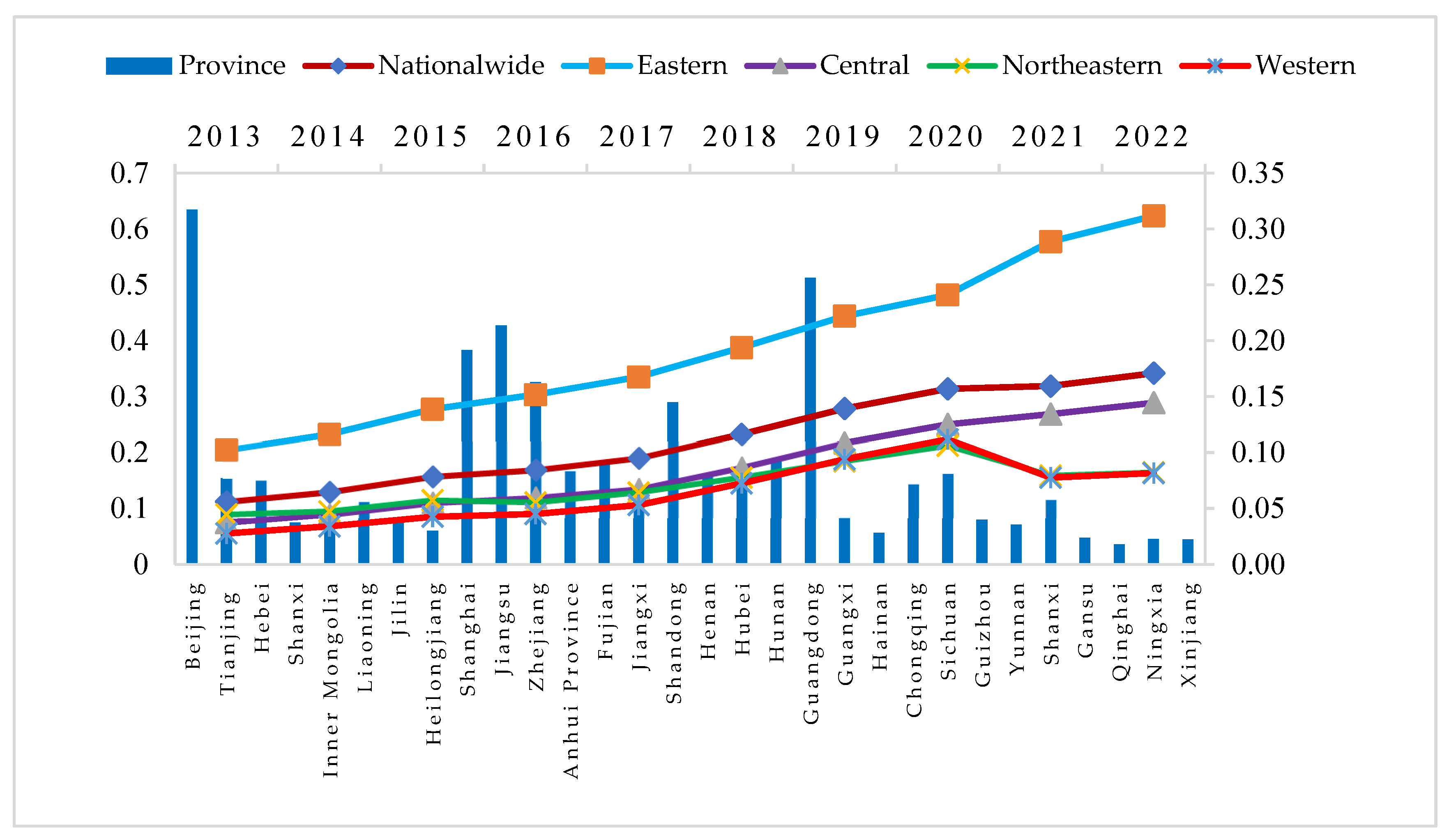
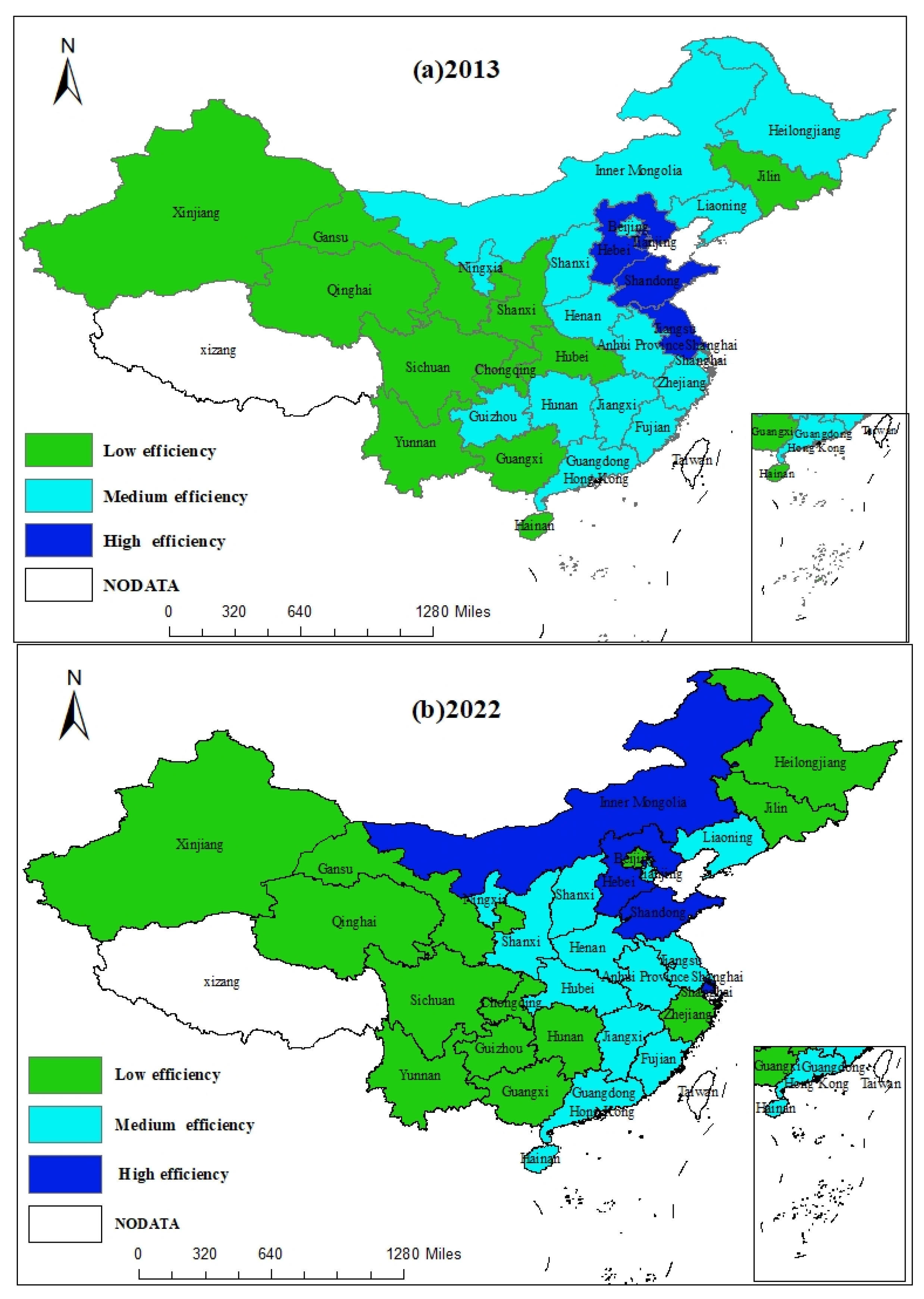
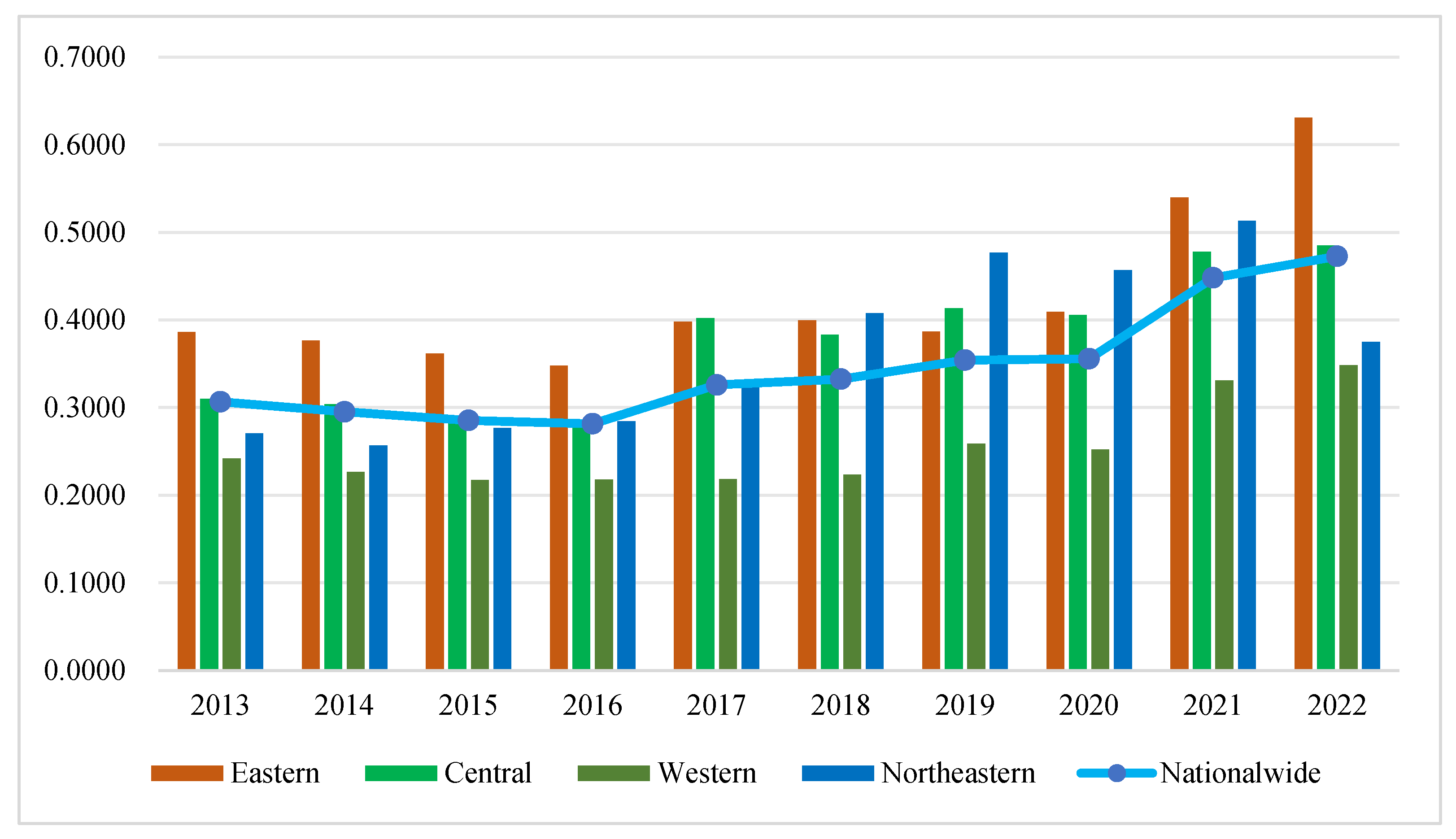
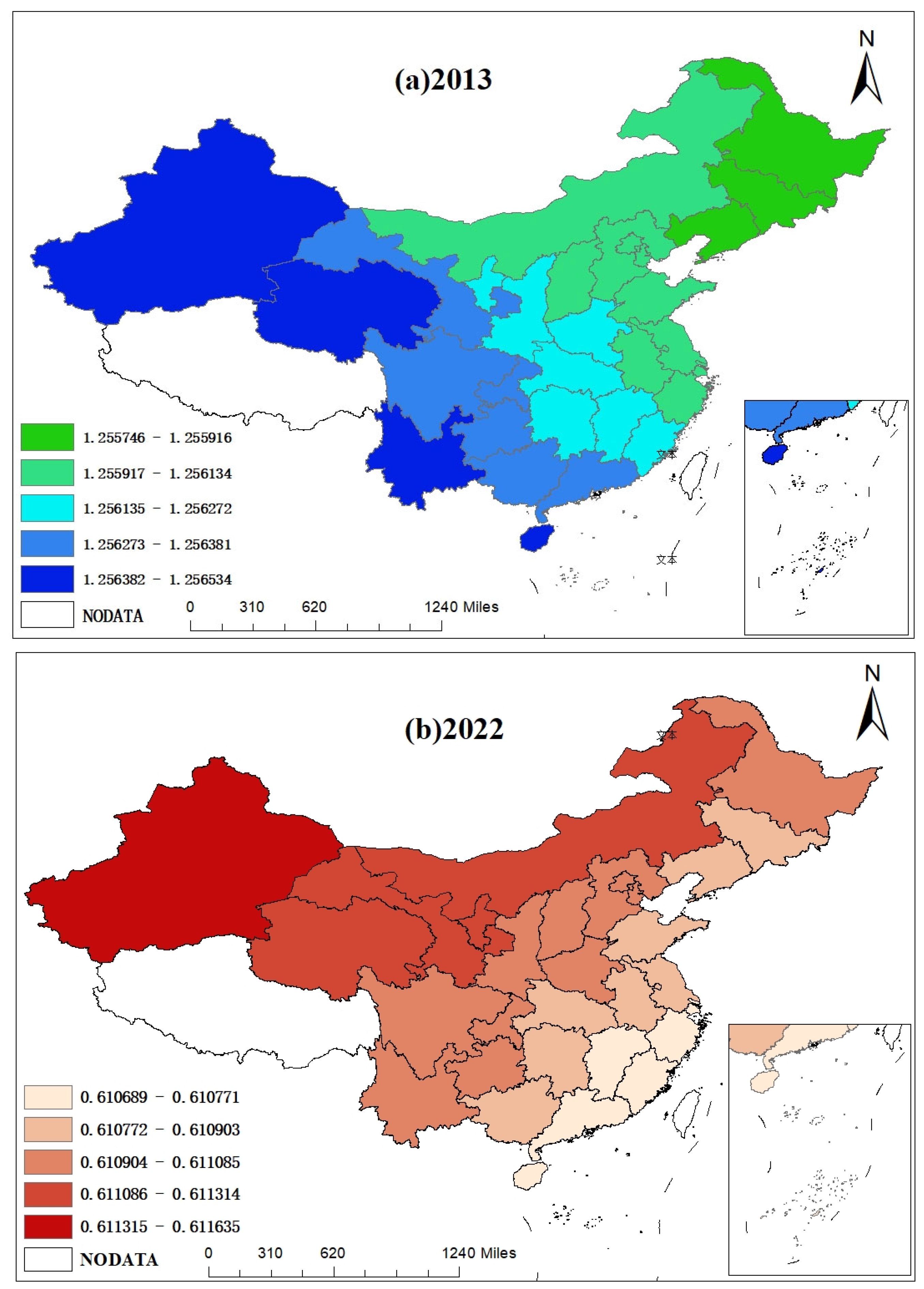
| Target Layer | Primary Indicators | Secondary Indicators | Symbol | Direction |
|---|---|---|---|---|
| CEE of the LI (LCE) | Input indicators | (Capital investment) fixed assets investment (CNY 100 million) | + | |
| (Labor input) LI employees (10,000 people) | + | |||
| (Energy input) energy consumption of the LI (10,000 tons of standard coal) | − | |||
| Output indicators | (Expected output) total output value of the LI (CNY 100 million) | + | ||
| (Unexpected output) CO2 emissions from the LI (10,000 tons) | − | |||
| Development level of DE (DE) | Digital infrastructure | Mobile phone penetration rate (unit/100 individuals) | + | |
| Fiber-optic cable line density (km/km2) | + | |||
| No. of domain names per person (pieces) | + | |||
| No. of web pages per person (pieces) | + | |||
| Digital industrialization | Proportion of software business revenue to the GDP | + | ||
| Per capita total telecommunications business (CNY 100 million) | + | |||
| Fixed assets investment in the information service industry (CNY 100 million) | + | |||
| No. of employees in the information transmission, software, and information technology service industries (10,000 individuals) | + | |||
| Digital innovation | Employment in scientific research and technology services industries (10,000 individuals) | + | ||
| Research and experimental development expenditure (CNY 100 million) | + | |||
| Total No. of undergraduate talents (individuals) | + | |||
| No. of patent applications per 10,000 people (pieces/10,000 individuals) | + | |||
| Industrial digitization | No. of websites owned by each hundred enterprises (pieces) | + | ||
| E-commerce transaction volume (sales revenue: CNY 100 million) | + | |||
| No. of enterprise e-commerce situations (including e-commerce enterprises/total No. of enterprises) | + | |||
| Digital Inclusive Finance Index | + |
| Variable Type | Variable Name | Measurement Indicators | Symbol |
|---|---|---|---|
| Dependent variable | CEE of the LI | SBM calculation result | LCE |
| Explanatory variables | Development level of DE | Linear weighting method composite index | DE |
| Control variables | Development level of the LI | Proportion of the LI’s output value to GDP | LDL |
| Economic development level | Per capita GDP | RJGDP | |
| Integrity with the outside world level | Percentage of GDP that comes from all imports and exports | OPEN | |
| Industrial structure | Percentage of GDP attributable to the secondary industry’s output value | IS | |
| Rules pertaining to the environment | Percentage of industrial added value from completed investments in pollution control | ER |
| Province | 2013 | 2014 | 2015 | 2016 | 2017 | 2018 | 2019 | 2020 | 2021 | 2022 | Mean | |
|---|---|---|---|---|---|---|---|---|---|---|---|---|
| 1 | Beijing | 0.3219 | 0.3064 | 0.3340 | 0.3443 | 0.2934 | 0.1656 | 0.2511 | 0.2407 | 0.2938 | 0.3150 | 0.2866 |
| 2 | Tianjin | 0.4569 | 0.3743 | 0.3992 | 0.4006 | 0.5516 | 1.0498 | 0.4592 | 0.4279 | 0.4889 | 0.6339 | 0.5242 |
| 3 | Hebei | 0.5972 | 0.6342 | 0.6194 | 0.5750 | 0.6697 | 0.6493 | 0.6705 | 0.7791 | 1.0398 | 1.0167 | 0.7251 |
| 4 | Shanxi | 0.3085 | 0.2976 | 0.3143 | 0.3291 | 0.8991 | 0.6602 | 0.4686 | 0.4897 | 0.5681 | 0.4942 | 0.4829 |
| 5 | Inner Mongolia | 0.3846 | 0.3837 | 0.3272 | 0.3429 | 0.3455 | 0.5799 | 0.4780 | 0.5255 | 0.8741 | 0.8428 | 0.5084 |
| 6 | Liaoning | 0.2822 | 0.2806 | 0.4029 | 0.4317 | 0.5422 | 0.6880 | 1.0306 | 0.9331 | 1.0225 | 0.6181 | 0.6232 |
| 7 | Jilin | 0.2483 | 0.2285 | 0.2082 | 0.2038 | 0.2177 | 0.2883 | 0.2322 | 0.2742 | 0.3297 | 0.3214 | 0.2552 |
| 8 | Heilongjiang | 0.2814 | 0.2606 | 0.2189 | 0.2175 | 0.2232 | 0.2462 | 0.1674 | 0.1634 | 0.1871 | 0.1847 | 0.2150 |
| 9 | Shanghai | 0.3435 | 0.4503 | 0.3112 | 0.3007 | 0.3216 | 0.2922 | 0.4054 | 0.5159 | 0.7422 | 1.0159 | 0.4699 |
| 10 | Jiangsu | 0.5337 | 0.4231 | 0.4149 | 0.4232 | 0.4359 | 0.4030 | 0.4168 | 0.4678 | 0.6469 | 0.5706 | 0.4736 |
| 11 | Zhejiang | 0.3163 | 0.3315 | 0.3109 | 0.3253 | 0.3337 | 0.2843 | 0.3123 | 0.2894 | 0.3404 | 0.3902 | 0.3234 |
| 12 | Anhui Province | 0.2681 | 0.2532 | 0.2294 | 0.2174 | 0.2213 | 0.3493 | 0.4995 | 0.5108 | 0.5770 | 0.5621 | 0.3688 |
| 13 | Fujian | 0.3288 | 0.3468 | 0.3711 | 0.3914 | 0.4168 | 0.2474 | 0.3157 | 0.3498 | 0.4491 | 0.5079 | 0.3725 |
| 14 | Jiangxi | 0.3965 | 0.3270 | 0.3035 | 0.3034 | 0.3801 | 0.3599 | 0.4155 | 0.3961 | 0.4728 | 0.5209 | 0.3876 |
| 15 | Shandong | 0.4754 | 0.3766 | 0.3640 | 0.3782 | 0.4027 | 0.4367 | 0.4225 | 0.4553 | 0.6239 | 1.0043 | 0.4940 |
| 16 | Henan | 0.3246 | 0.3850 | 0.3418 | 0.3636 | 0.3653 | 0.3882 | 0.4572 | 0.4379 | 0.5456 | 0.5935 | 0.4203 |
| 17 | Hubei | 0.2304 | 0.2365 | 0.2259 | 0.2031 | 0.2190 | 0.2482 | 0.3392 | 0.2965 | 0.3703 | 0.4104 | 0.2780 |
| 18 | Hunan | 0.3320 | 0.3248 | 0.3048 | 0.3028 | 0.3275 | 0.2930 | 0.3003 | 0.3022 | 0.3345 | 0.3303 | 0.3152 |
| 19 | Guangdong | 0.3172 | 0.3183 | 0.3116 | 0.1630 | 0.3321 | 0.2680 | 0.3011 | 0.2877 | 0.3669 | 0.4114 | 0.3077 |
| 20 | Guangxi | 0.2398 | 0.2306 | 0.2364 | 0.2355 | 0.2533 | 0.1843 | 0.2125 | 0.2183 | 0.2557 | 0.2662 | 0.2333 |
| 21 | Hainan | 0.1705 | 0.2052 | 0.1794 | 0.1786 | 0.2217 | 0.1984 | 0.3121 | 0.2795 | 0.4046 | 0.4452 | 0.2595 |
| 22 | Chongqing | 0.1929 | 0.2199 | 0.2084 | 0.2176 | 0.2210 | 0.1959 | 0.2390 | 0.2289 | 0.2886 | 0.3205 | 0.2333 |
| 23 | Sichuan | 0.1669 | 0.1837 | 0.2082 | 0.2103 | 0.2161 | 0.1592 | 0.1972 | 0.1922 | 0.2230 | 0.2230 | 0.1980 |
| 24 | Guizhou | 0.3670 | 0.3575 | 0.3608 | 0.3618 | 0.3820 | 0.1844 | 0.2227 | 0.2235 | 0.2861 | 0.2908 | 0.3037 |
| 25 | Yunnan | 0.0920 | 0.0836 | 0.0834 | 0.0825 | 0.0801 | 0.1617 | 0.2368 | 0.2361 | 0.2866 | 0.3204 | 0.1663 |
| 26 | Shanxi | 0.2373 | 0.2250 | 0.1982 | 0.2052 | 0.2036 | 0.2187 | 0.2469 | 0.2778 | 0.3933 | 0.4128 | 0.2619 |
| 27 | Gansu | 0.2374 | 0.1398 | 0.1366 | 0.1197 | 0.1341 | 0.1956 | 0.2048 | 0.1842 | 0.2287 | 0.2769 | 0.1858 |
| 28 | Qinghai | 0.1100 | 0.1084 | 0.1165 | 0.1064 | 0.1025 | 0.1069 | 0.1375 | 0.1272 | 0.1619 | 0.1737 | 0.1251 |
| 29 | Ningxia | 0.4174 | 0.3552 | 0.3211 | 0.2875 | 0.2830 | 0.2628 | 0.3395 | 0.3617 | 0.4137 | 0.4134 | 0.3455 |
| 30 | Xinjiang | 0.2172 | 0.2069 | 0.1954 | 0.2258 | 0.1821 | 0.2061 | 0.3318 | 0.1977 | 0.2259 | 0.2912 | 0.2280 |
| Year | Moran’s I | Z-Score | p-Value |
|---|---|---|---|
| 2013 | 0.3522 | 3.1925 | 0.0014 *** |
| 2014 | 0.3796 | 3.5019 | 0.0005 *** |
| 2015 | 0.4115 | 3.7767 | 0.0002 *** |
| 2016 | 0.3925 | 3.5143 | 0.0004 *** |
| 2017 | 0.2502 | 2.4264 | 0.0153 ** |
| 2018 | 0.2599 | 2.5250 | 0.0116 ** |
| 2019 | 0.3014 | 3.0966 | 0.0020 *** |
| 2020 | 0.3951 | 3.6766 | 0.0002 *** |
| 2021 | 0.4077 | 3.6732 | 0.0002 *** |
| 2022 | 0.3429 | 3.1296 | 0.0017 *** |
| Variable | DE2013 | LGL2013 | IS2013 | OPEN2013 | ER2013 | RJGDP2013 |
| VIF value | 6.6393 | 1.5699 | 1.7035 | 7.1516 | 1.9478 | 2.7402 |
| Variable | DE2016 | LGL2016 | IS2016 | OPEN2016 | ER2016 | RJGDP2016 |
| VIF value | 4.2537 | 1.1427 | 1.3231 | 3.9486 | 1.0879 | 2.9018 |
| Variable | DE2019 | LGL2019 | IS2019 | OPEN2019 | ER2019 | RJGDP2019 |
| VIF value | 5.6651 | 1.8129 | 1.1551 | 6.2353 | 1.6608 | 6.7596 |
| Variable | DE2022 | LGL2022 | IS2022 | OPEN2022 | ER2022 | RJGDP2022 |
| VIF value | 4.9126 | 1.3509 | 1.4769 | 7.3928 | 1.10153 | 5.0314 |
| Model Parameters | 2013 | 2016 | 2019 | 2022 | ||||
|---|---|---|---|---|---|---|---|---|
| GWR | OLS | GWR | OLS | GWR | OLS | GWR | OLS | |
| R | 0.6374 | 0.6373 | 0.6620 | 0.6618 | 0.3913 | 0.3909 | 0.7071 | 0.7069 |
| Variable | DE | LGL | IS | OPEN | ER | RJGDP | ||||||
|---|---|---|---|---|---|---|---|---|---|---|---|---|
| Year | 2013 | 2022 | 2013 | 2022 | 2013 | 2022 | 2013 | 2022 | 2013 | 2022 | 2013 | 2022 |
| Max | 1.2565 | 0.6116 | 5.1633 | 18.4101 | 0.4468 | 0.1732 | −0.0741 | −0.0337 | −3.3099 | 11.7346 | 0.0148 | 0.0250 |
| Median | 1.2562 | 0.6109 | 5.1623 | 18.4083 | 0.4466 | 0.1728 | −0.0741 | −0.0338 | −3.3193 | 11.7017 | 0.0148 | 0.0250 |
| Min | 1.2557 | 0.6107 | 5.1614 | 18.4065 | 0.4465 | 0.1721 | −0.0742 | −0.0340 | −3.3276 | 11.6218 | 0.0148 | 0.0249 |
Disclaimer/Publisher’s Note: The statements, opinions and data contained in all publications are solely those of the individual author(s) and contributor(s) and not of MDPI and/or the editor(s). MDPI and/or the editor(s) disclaim responsibility for any injury to people or property resulting from any ideas, methods, instructions or products referred to in the content. |
© 2024 by the authors. Licensee MDPI, Basel, Switzerland. This article is an open access article distributed under the terms and conditions of the Creative Commons Attribution (CC BY) license (https://creativecommons.org/licenses/by/4.0/).
Share and Cite
Guo, Y.; Wu, X.; Ding, H.; Tian, Z. Spatial Influence of Digital Economy on Carbon Emission Efficiency of the Logistics Industry across 30 Provinces in China. Sustainability 2024, 16, 8086. https://doi.org/10.3390/su16188086
Guo Y, Wu X, Ding H, Tian Z. Spatial Influence of Digital Economy on Carbon Emission Efficiency of the Logistics Industry across 30 Provinces in China. Sustainability. 2024; 16(18):8086. https://doi.org/10.3390/su16188086
Chicago/Turabian StyleGuo, Yuxia, Xue Wu, Heping Ding, and Zhouyu Tian. 2024. "Spatial Influence of Digital Economy on Carbon Emission Efficiency of the Logistics Industry across 30 Provinces in China" Sustainability 16, no. 18: 8086. https://doi.org/10.3390/su16188086
APA StyleGuo, Y., Wu, X., Ding, H., & Tian, Z. (2024). Spatial Influence of Digital Economy on Carbon Emission Efficiency of the Logistics Industry across 30 Provinces in China. Sustainability, 16(18), 8086. https://doi.org/10.3390/su16188086






